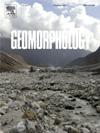美国板块内新马德里地震带外围第四纪晚期断层的地形山脊:其构造影响
IF 3.1
2区 地球科学
Q2 GEOGRAPHY, PHYSICAL
引用次数: 0
摘要
长期以来,人们一直推测毗邻北美板块内部新马德里地震带(NMSZ)的上新世和第四纪沉积物中的东北走向线状地形山脊是与密西西比河谷裂谷东缘基底断层重新活化有关的新构造地貌。地震震中和古地震学研究表明,密西西比河谷裂谷断裂复合体约束弯以南的东部裂谷边缘断层(ERMF)在第四纪晚期十分活跃,但约束弯以北的ERMF区(ERM-N)和线性山脊下层则处于地震静止状态。之前对最突出的线性山脊(里夫线)进行的 P 波地震反射勘测显示,该山脊覆盖在始新世沉积物的一个地角之上。为了确定里夫斯线状构造是否由地表断层/褶皱产生,我们采集了电阻率层析成像(ERT)和地面穿透雷达(GPR)剖面图,对该脊的浅表次表层特征进行成像。我们在 ERT 和 GPR 图像中解释了晚更新世沉积物的浅层褶皱和断层。此外,我们还对里夫斯线边缘疤痕的多个地形剖面的凸度进行了量化,并将其与该地区已知新构造疤痕和河流阶地隆起剖面的凸度进行了比较。对这些剖面进行比较后发现,里夫斯褶皱带边缘的疤痕与全新世的里尔富特推力疤痕具有高度的相似性。综合这些结果,我们强烈认为晚更新世或全新世的褶皱和断层造成了这一山脊,尽管它目前处于地震静止状态,因此它们为评估一般走向滑动系统中静止断层的地震危险潜力提供了有用的见解。我们的结论是,记录在案的第四纪晚期里尔富特推力上的一系列运动是在更新世晚期或全新世早期ERM-N上的转压断层运动不活跃之后为适应地壳缩短而开始的,如果里尔富特推力在未来有一段时间不活跃,ERM-N上的运动可能会恢复。我们的研究结果表明,走向滑动系统中的断层相互作用可能会发生变化,从而使具有巨大地震潜力的断层看起来似乎处于不活跃状态。本文章由计算机程序翻译,如有差异,请以英文原文为准。
Topographic ridges express late Quaternary faulting peripheral to the New Madrid seismic zone, intraplate USA: Their tectonic implications
Northeast-trending linear topographic ridges in Pliocene and Quaternary sediments adjacent to the New Madrid seismic zone (NMSZ), intraplate North America, have been long speculated to be neotectonic landforms related to reactivation of basement faults of the eastern Mississippi Valley Rift margin. Earthquake epicenters and paleoseismological studies show that eastern rift margin faults (ERMF) were active during late Quaternary south of a restraining bend in the Mississippi Valley Rift fault complex, but the ERMF zone north of the restraining bend (ERM-N) and underlying the linear ridges is seismically quiescent. A previous P-wave seismic reflection survey across the most prominent linear ridge (Rives lineament) revealed that it overlies a horst in Eocene sediment. To ascertain whether the Rives lineament could have been produced by surface faulting/folding, we collected electrical resistivity tomography (ERT) and ground penetrating radar (GPR) profiles to image the ridge's shallow subsurface features. We interpret shallow folding and faulting of late Pleistocene sediment in our ERT and GPR images. Additionally, convexity of multiple topographic profiles of scarps along margins of the Rives lineament was quantified and compared to the convexity of profiles of known neotectonic scarps and of fluvial terrace riser profiles within the region. Comparison of these profiles reveals a high degree of similarity between the scarps along the Rives lineament margins and the Holocene Reelfoot thrust scarp. When combined, our results strongly suggest late Pleistocene or Holocene folding and faulting created this ridge despite its current seismic quiescence, and thus they provide useful insight for assessing the seismic hazard potential of quiescent faults in strike-slip systems in general. We conclude that the late Quaternary series of movements documented on the Reelfoot thrust was initiated to accommodate crustal shortening after transpressional fault movements on the ERM-N became inactive in late Pleistocene or early Holocene and that movement along the ERM-N may resume if the Reelfoot thrust has an interval of inactivity in the future. Our results suggest how fault interactions within a strike-slip system can change, making faults with significant amounts of seismic potential appear as though they are inactive.
求助全文
通过发布文献求助,成功后即可免费获取论文全文。
去求助
来源期刊

Geomorphology
地学-地球科学综合
CiteScore
8.00
自引率
10.30%
发文量
309
审稿时长
3.4 months
期刊介绍:
Our journal''s scope includes geomorphic themes of: tectonics and regional structure; glacial processes and landforms; fluvial sequences, Quaternary environmental change and dating; fluvial processes and landforms; mass movement, slopes and periglacial processes; hillslopes and soil erosion; weathering, karst and soils; aeolian processes and landforms, coastal dunes and arid environments; coastal and marine processes, estuaries and lakes; modelling, theoretical and quantitative geomorphology; DEM, GIS and remote sensing methods and applications; hazards, applied and planetary geomorphology; and volcanics.
 求助内容:
求助内容: 应助结果提醒方式:
应助结果提醒方式:


